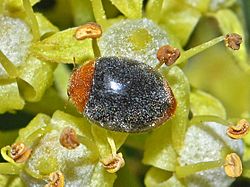Cryptolaemus montrouzieri facts for kids
Quick facts for kids Cryptolaemus montrouzieri |
|
|---|---|
 |
|
| Cryptolaemus montrouzieri. Dorsal view | |
 |
|
| Side view | |
| Scientific classification | |
| Kingdom: | |
| Phylum: | |
| Class: | |
| Order: | |
| Family: | |
| Genus: |
Cryptolaemus
|
| Species: |
C. montrouzieri
|
| Binomial name | |
| Cryptolaemus montrouzieri Mulsant, 1850
|
|
The Cryptolaemus montrouzieri, often called the mealybug ladybird or mealybug destroyer, is a special type of ladybird. It's known for helping control pests in gardens and farms.
Contents
What's in a Name?
A scientist named Étienne Mulsant first described this ladybird in 1850. He named it after a missionary and insect expert, Jean Xavier Hyacinthe Montrouzier. Montrouzier wrote about insects he found on Woodlark Island.
Where Do They Live?
This mealybug ladybird originally comes from Queensland and New South Wales in Australia.
However, people have moved them to many other parts of the world. You can now find them in southern Europe (like France, Italy, Spain, and Greece). They also live in North Africa, parts of Africa, North America, and South America.
What Do They Look Like?
Adult mealybug ladybirds are about 6 millimeters (about a quarter of an inch) long. They have the usual ladybird shape. Unlike many colorful ladybirds, these are mostly dark brown. They do not have any spots. Their head, antennae, front part of their body, the end of their wing covers, and their legs are orange-brown.
Their larvae (young ladybirds) are quite a bit bigger, growing up to 14 to 15 millimeters long. They have a waxy, white covering. This makes them look a lot like the mealybugs they eat! This clever disguise helps them get closer to their prey.
Life and Habits
Both the adult mealybug ladybirds and their larvae love to eat scale insects, especially mealybugs. Mealybugs are tiny insects that can harm plants.
Female ladybirds lay their eggs right among the mealybugs' egg sacs. Once the ladybird larvae hatch, they start eating mealybug eggs, young mealybugs, and the sticky "honeydew" that mealybugs produce.
It takes about 24 days for a larva to grow into an adult ladybird. They go through three larval stages and then a pupa stage before becoming adults. An adult mealybug ladybird usually lives for about two months.
Helping Farmers and Gardeners
This ladybird species is very useful for biological control. This means they are used as a natural way to fight pests without using harmful chemicals. They are often called "mealybug destroyers" when used this way.
For example, these ladybirds were brought to Western Australia to help control mealybugs there. In California, they were introduced in 1891 to fight the citrus mealybug, which damages citrus fruit trees. They have also been brought to New Zealand for the same purpose.
See also
 In Spanish: Cryptolaemus montrouzieri para niños
In Spanish: Cryptolaemus montrouzieri para niños



